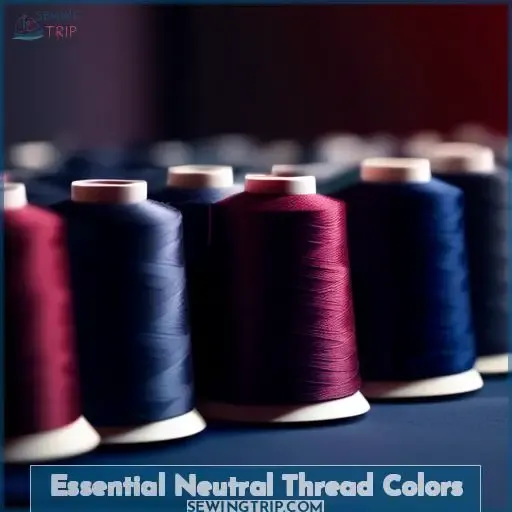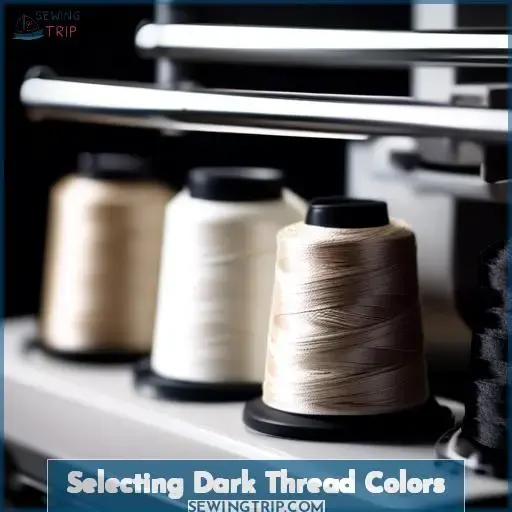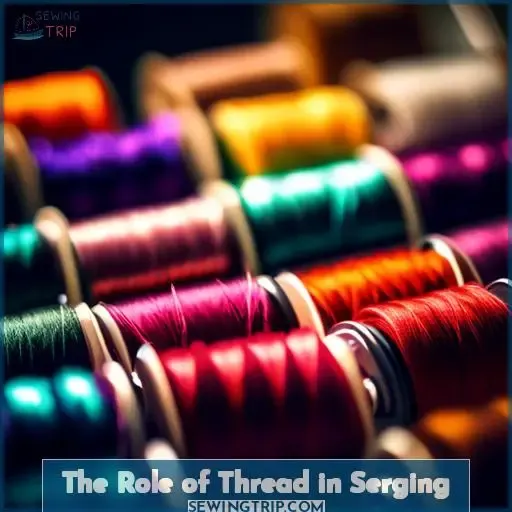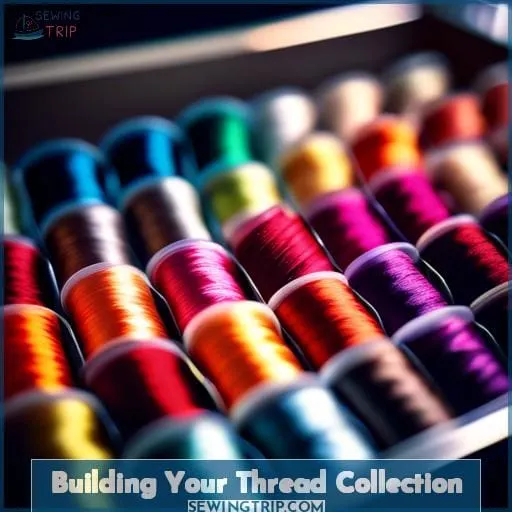This site is supported by our readers. We may earn a commission, at no cost to you, if you purchase through links.
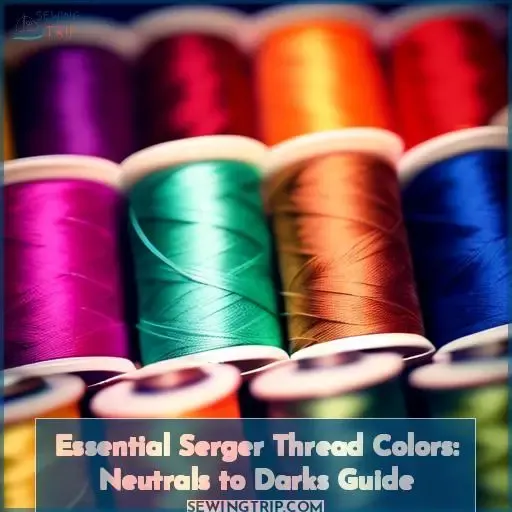 Selecting the right serger thread colors is crucial for your sewing projects.
Selecting the right serger thread colors is crucial for your sewing projects.
This guide dives into the essential neutrals and darks, from the versatility of black, white, and gray, to the importance of navy and brown.
You’ll learn which threads are visible in a seam and how to prioritize colors for the outside needle position.
With tips on building your thread collection and maximizing usage, you’re set to elevate your serging skills with practicality and innovation.
Table Of Contents
Key Takeaways
- Keep a range of neutral thread colors such as black, white, and gray, as they can blend well with a variety of fabric colors and textures, and are less visible in seams.
- Include dark thread colors like navy, brown, and black in your collection to match or coordinate with dark fabrics, and to provide a suitable contrast for fabric patterns.
- In serging, prioritize the color of the thread for the outside needle position since it is the most visible, and consider the size and weight of the thread for the specific needs of the project.
- Build a practical thread collection that includes cool and warm neutrals, and consider using color-coded spools or thread subscriptions to manage your inventory efficiently, while also being mindful of thread needle compatibility and storage methods.
What Color Serger Thread Should I Have on Hand
To ensure you’re prepared for various sewing projects, it’s recommended to have a range of serger thread colors on hand, including neutrals like black, gray, white, and navy, as well as a few versatile darks such as charcoal and brown.
These colors can blend well with most fabrics, making them essential for your sewing toolkit.
Essential Neutral Thread Colors
When it comes to serging, having black, white, and gray threads on hand is crucial. These neutrals match a wide range of fabrics, making them versatile choices for your projects.
Versatility of Black, White, and Gray Threads
In the serging game, black, white, and gray threads are your trusty sidekicks.
Their versatility is unmatched, effortlessly jiving with nearly any fabric hue.
These neutrals are the backbone of color matching, offering practicality that can’t be overstated.
Whether you’re stitching up a storm or just starting out, they’re the go-to hues that’ll never steer you wrong.
Matching These Neutrals With a Wide Range of Fabrics
Matching black, white, and gray threads with various fabrics is like finding the perfect dance partner; it’s all about harmony. These neutrals are chameleons, blending seamlessly across a spectrum of fabric textures and colors.
- Color blending: Effortlessly merges with any fabric hue.
- Fabric texture: Enhances texture without overpowering.
- Seam visibility: Minimizes contrast, making seams less noticeable.
A stitch in time saves nine, especially with the right color substitution!
Selecting Dark Thread Colors
When selecting dark thread colors for your serging projects, it’s crucial to have navy, brown, and black on hand. These shades ensure you can match the thread closely with a wide variety of dark fabrics.
Importance of Navy, Brown, and Black for Dark Fabrics
Transitioning from the essential neutrals, let’s dive into the dark side of serging. Navy, brown, and black threads are your go-to for dark fabrics, ensuring seamless blends and invisible seams.
These colors are the backbone of any project involving darker materials. Think of them as your secret weapons, making every stitch count without drawing unwanted attention to the thread itself.
How to Choose the Right Dark Thread for Your Project
Choosing the right dark thread for your project isn’t rocket science, but it does require a keen eye.
- Coordinate with the fabric shade for a seamless look.
- Contrast with fabric patterns to add pizzazz.
- Match thread to fabric texture for harmony.
- Consider thread size and weight for durability.
- Explore alternative dark colors to spice things up.
The Role of Thread in Serging
In serging, it’s crucial to know which threads will be visible in your seam.
You’ll want to prioritize the color for the outside needle position to ensure a seamless look.
Understanding Which Threads Are Visible in a Seam
Transitioning from selecting dark thread colors, let’s dive into the essence of seam crafting.
In serging, thread visibility plays a pivotal role in seam appearance. Opt for threads that blend seamlessly with your fabric to enhance stitch definition without stark fabric contrast.
Prioritizing Thread Color for the Outside Needle Position
After grasping which threads show in a seam, focus on the outside needle thread—it’s your serger’s frontman.
Choose a contrasting thread that complements the fabric texture, adding subtle details without overpowering. Think of it as the satin stitch of decorative serging: a touch of finesse that turns a simple seam into a statement.
Keep it snappy and smart!
Building Your Thread Collection
As you grow your serging skills, it’s smart to gradually expand your thread collection.
Consider both variety and practicality to ensure you have the right colors for any project.
Balancing Variety With Practicality
As you’ve learned which threads show up where, you’re ready to build a savvy collection.
Start with matching cool and warm neutrals, then sprinkle in complementary and analogous colors.
Aim for a versatile palette that covers most projects without overstuffing your storage.
It’s a tightrope walk between rainbow dreams and practical space!
Strategies for Expanding Your Thread Colors Over Time
As you grow your serger thread stash, aim for cost-conscious purchases.
Start with color-coded spools for quick identification.
Consider thread subscriptions for a steady influx of new hues.
Don’t overlook vintage thread for unique finds.
Finally, invest in smart thread storage solutions to keep your collection organized and accessible.
This approach ensures your thread arsenal evolves efficiently and creatively.
Tips for Efficient Thread Use
To make the most of your serger thread collection, focus on versatile hues that serve multiple purposes.
Adopt techniques that reduce the need to switch threads, saving you time and effort.
Maximizing Thread Usage With Multi-purpose Colors
You’ll want to get savvy with your serger, so consider multi-purpose selection your best pal.
Opt for threads that play well with numerous fabrics, boosting your thread swapping efficiency.
Master color blending techniques and fabric matching strategies to make those spools stretch further.
Hunt for complementary thread combinations that’ll have your projects looking sharp without the constant re-threading hustle.
Keep it snappy and smart!
Techniques for Swapping Threads Less Frequently
After mastering multi-purpose colors, let’s dive into swapping threads less often.
- Serger Thread Management: Keep tension consistent; avoid frequent changes.
- Thread Needle Compatibility: Match thread to needle size for fewer swaps.
- Thread Storage Methods: Organize by color and type for quick selection.
Embrace these strategies to streamline your serging process, ensuring your focus remains on creativity, not thread juggling.
Frequently Asked Questions (FAQs)
How does thread fiber content affect serging?
Thread fiber content shapes your serging experience; cotton stays put during high-speed quilting.
Polyester’s stretch suits wearable fabrics.
Silk’s finesse is perfect for delicate pieces.
Choose wisely for seamless results!
Can I use regular sewing thread in a serger?
Yes, you can use regular sewing thread in a serger. However, you’ll need to adjust the tension as it’s slightly thicker than serger thread.
What’s the best thread for stretchy fabrics?
For stretchy fabrics, you’ll want to stick with polyester thread. It’s got a bit of give, making it perfect for those stretch-and-recover situations.
Say goodbye to popped seams and hello to durable, flexible finishes.
How often should I replace my serger thread?
Imagine you’re a marathon runner; your serger thread is your sneakers.
Just as sneakers wear out, so does thread.
Replace it when it becomes brittle or loses color, ensuring your projects cross the finish line in style.
Are there eco-friendly serger thread options available?
Yes, eco-friendly serger thread options exist. Brands like A&E and Organic Cotton Plus offer threads made from recycled or organic materials.
Ensuring your sewing projects are as green as they’re gorgeous.
Conclusion
Surely, you’ve chuckled at the thought of a serger thread color causing a fashion faux pas.
But let’s get serious: having the right serger thread colors on hand is no joke.
Opt for versatile neutrals like black, white, and gray, and don’t forget the dark but crucial navy and brown.
Prioritize your outside needle with the most visible color.
As you build your collection, focus on multi-purpose hues to streamline your serging process.
Now, thread with confidence and let your creativity surge!

